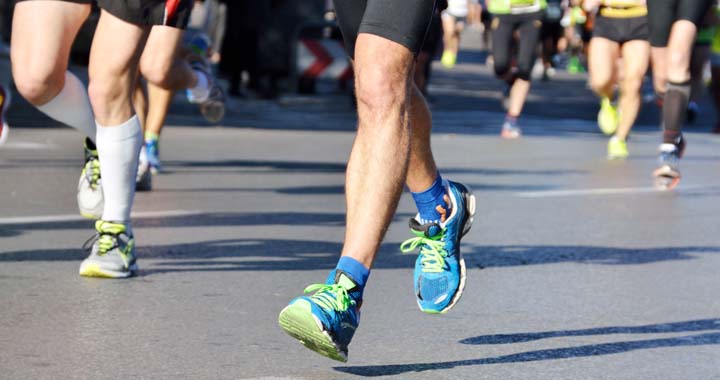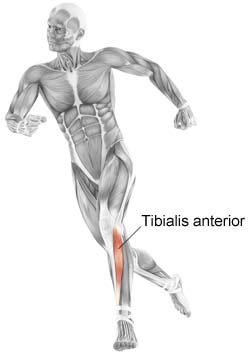
Shin splints are an overuse injury that causes pain in on the front side of the upper tibia. Shin splints affect runners, tennis players, hikers, dancers, and other people who participate in activities that involve running and jumping. Runners who suddenly increase their distance or who run downhill are especially vulnerable. Even tourists who have a normally sedentary lifestyle and suddenly walk long distances while on vacation are prone to shin splints.
Shin splint pain often has a burning feeling and worsens after exercise or even the following day. Overuse causes inflammation or small tears in the tibialis anterior muscle where it is attached to the tibia. The pain is usually noticeable when exercise begins, then decreases as the activity continues.
It’s important to note that there are two serious conditions that can be confused with shin splints. The first, anterior compartment syndrome, is a medical emergency that can cause permanent muscle damage. The second is a stress fracture of the tibia which can get more serious if left untreated. See a doctor to be sure you know what is causing your shin pain before you attempt to treat the problem yourself or have it treated. It is outside the scope of practice of a massage therapist to diagnose the exact nature of the problem and you do not want to guess.
Anatomy
 The tibialis anterior starts just below the knee at the lateral (outside) condyle of the tibia and is firmly attached to the upper half or two-thirds of the shaft of the tibia. The muscle ends in a tendon that wraps across to the medial (inside) side of the leg near the ankle and attaches to the bones on the bottom of the foot and the base of the big toe. The tibialis anterior is actively involved in every step you take, making it very prone to overuse injuries. It contracts to lift the toes. It also helps invert the foot.
The tibialis anterior starts just below the knee at the lateral (outside) condyle of the tibia and is firmly attached to the upper half or two-thirds of the shaft of the tibia. The muscle ends in a tendon that wraps across to the medial (inside) side of the leg near the ankle and attaches to the bones on the bottom of the foot and the base of the big toe. The tibialis anterior is actively involved in every step you take, making it very prone to overuse injuries. It contracts to lift the toes. It also helps invert the foot.
The main action of the tibialis anterior is to stabilize the ankle and control the descent of the forefoot after the heel strikes the ground. Its main function is not to contract, but to lengthen in a controlled fashion every time you take a step. As the heel of your leading foot touches the ground it becomes weight-bearing and the tibialis anterior muscle has to work hard to prevent the front of the foot from slapping to the ground. That’s why running or walking downhill makes you especially prone to shin splints—the muscle has to work through a greater range as it lowers your toes further to the ground. Controlled lengthening is thought to be a main contributor to delayed onset muscle soreness (DOMS).
Role of Massage
 Massage therapy can be very beneficial in helping reduce the pain caused by shin splints and as a maintenance tool to help with prevention. There is a trigger point near the upper portion of the tibialis anterior that is often very tender even when there are no symptoms of shin splints. Pain resulting from stimulating that trigger point will sometimes radiate down into the big toe. Therapeutic massage using trigger point therapy can deactivate that point to ease the pain. Friction and stripping of the tibialis anterior needs to be done carefully so as not to exacerbate the already-inflamed tissue.
Massage therapy can be very beneficial in helping reduce the pain caused by shin splints and as a maintenance tool to help with prevention. There is a trigger point near the upper portion of the tibialis anterior that is often very tender even when there are no symptoms of shin splints. Pain resulting from stimulating that trigger point will sometimes radiate down into the big toe. Therapeutic massage using trigger point therapy can deactivate that point to ease the pain. Friction and stripping of the tibialis anterior needs to be done carefully so as not to exacerbate the already-inflamed tissue.
Therapeutic massage for shin splints should also include work on the gastrocnemius and soleus, the big muscles on the back of the calf. They are home to trigger points of their own and full attention to the lower leg during massage can relieve tightness and help prevent problems from occurring. Petrissage, a kneading stroke, and friction along the length of those muscles feel especially good and helps relieve built-up tightness.
People who engage in activities that involve running and jumping should consider regular maintenance sports massage to be an important part of their training program. Regular work on the lower leg keeps the muscles supple and helps prevent problems such as shin splints. Make an appointment today to find relief for your shin splint pain.


